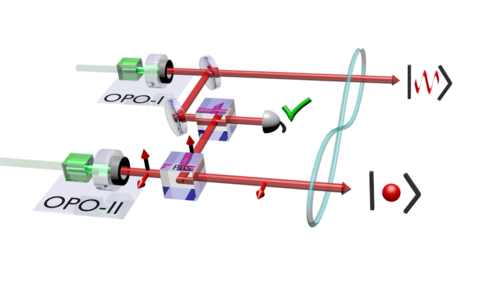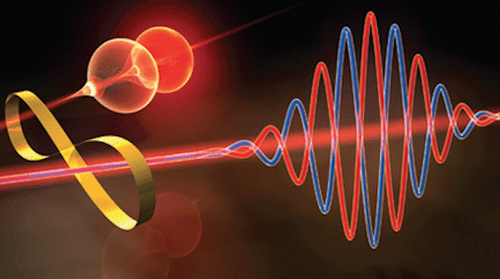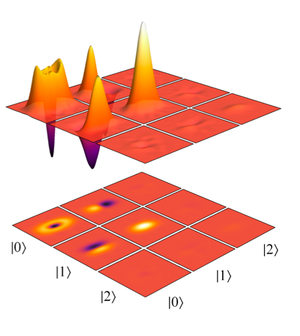Hybrid entanglement
Focus on Hybrid Entanglement of Light
Hybrid entanglement corresponds to a novel form of optical entanglement between a qubit encoded with a single-photon and a qubit encoded in classical light waves with opposite phases, i.e. a state |0>A | α >B+|1>A|-α>B shared between Alice (who works for instance only with discrete variables) and Bob (who works only with continuous-variables). This shared resource enables to convert information from one encoding to the other by teleportation. How to generate such a state?
The optical circuit developed in our team consists in using two distant continuous-wave optical parametric oscillators (OPO), which are based on non-linear crystals inserted into resonant optical cavities. These devices can emit non-classical states of light. By playing with the phase matching conditions in the non-linear process, these states can be different. A type-I phase matched OPO enables to prepare a single squeezed beam (with a noise reduction below the shot noise level) while a type-II OPO emits two beams, called twin beams as they are correlated in number of photons.
The procedure consists then in tapping a small part of the squeezed beam and mixing it on a 50/50 beamsplitter with one of the twin beams in an indistinguishable fashion. Conditioned on the detection of a single-photon at the output of the beamsplitter, the remaining beams are projected into the targeted entangled state. The entanglement is created, as there is no way, even in principle, to know if the single-photon is coming from one side or from the other.
Importantly, only single-photons propagate between the two distant sources. In this way, a lossy channel, such a very long fiber link, only affects the count rate but not the fidelity of the resulting state. The scheme enables thus the generation of entanglement at a distance. In our recent demonstration, the loss in this path was equivalent to 75 km of fiber.
How to measure and represent such a state?
The heralded state is characterized by a two-mode quantum tomography performed with two high-efficiency homodyne detections, one on each node. The two-mode density matrix of the state can then be reconstructed via a maximum likelihood algorithm. This new kind of hybrid state, which is composed of a discrete mode and a continuous one, raises the question of how to represent it in a visual and illustrative manner. We have chosen as a convenient representation to display in a matrix form the Wigner functions (well adapted to continuous-variable states) associated with the reduced density matrices <k||l>, where |k> and |l> indicate discrete-qubit states. The result can be seen in the figure. It confirms that the discrete mode is contained in the qubit subspace spanned by 0 or 1 photons. Higher-photon number are indeed limited to 2%. In this subspace the twofirst diagonal elements, correspond respectively to a photon-subtracted squeezed state and to a squeezed state. The non-zero off-diagonal terms demonstrate the coherence of the superposition. We are currently working on reaching higher dimensionalities and exploiting this resource for novel protocols, such as hybrid teleportation between CV and DV qubits.
For more details, Nature Photonics 8, 570 (2014)



